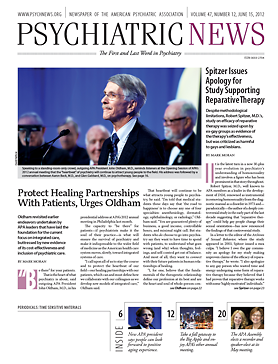Substance use is increasing among adolescents, yet existing psychosocial interventions to treat related disorders have shown only modest efficacy.
“Adolescents are more vulnerable to addiction in part because of rapid brain development that continues up to the mid-20s,” said Paula Riggs, M.D., a professor of psychiatry and director of the Division of Substance Dependence at the University of Colorado School of Medicine in Denver, at APA’s 2012 annual meeting in Philadelphia in May. “Whatever a teenager does affects brain development and pruning.”
Thus, addiction and mental illness frequently both have pediatric-onset and developmental contexts, and each is a risk factor for the other, she said.
Despite its benign reputation among the general public, marijuana is especially bad for adolescents because it disrupts development of the prefrontal cortex by way of the CB1 receptor’s regulatory role, she explained.
In addition, marijuana alters the reward response to other drugs, disrupts control over glutamate and GABA of the endogenous cannabinoid system, and can predispose vulnerable individuals to schizophrenia and other psychoses.
Treatment can be effective, but only about 10 percent of those who need it access care. Too often it produces only modest reductions in drug use, low abstinence, and high relapse rates.
One reason for the lack of success in treatment is that comorbidity is common, but treatments integrating behavioral and pharmacotherapy are few, she noted. Many adolescents would also benefit from early intervention, but most are physically healthy and see primary care clinicians too rarely.
Comorbidities may be a key to treating the substance abuse.
Riggs cited several clinical trials that combined medications with cognitive-behavioral therapy (CBT) to treat patients with drug use and other psychiatric comorbidities (like depression or ADHD). One tested fluoxetine and 16 weeks of CBT versus placebo plus CBT. Although depression remitted more often in patients treated with fluoxetine/CBT (70 percent) compared to placebo/CBT (52 percent), rates of depression remission were higher than expected in both groups, which suggests that CBT targeting substance abuse may have contributed to depression treatment response, said Riggs.
Furthermore, patients whose depression remitted, regardless of treatment group, significantly reduced their drug use, while nonremittters did not.
“Depression remission may be important to substance treatment outcomes,” she said. “So if depression symptoms don’t significantly decline at the end of the first month of substance treatment, fluoxetine should be considered—and closely monitored—because it appears to be safe and effective even in those not yet abstinent.”
Another similarly designed study indicated that OROS-methylphenidate may be both safe and beneficial for ADHD in adolescents concurrently receiving CBT substance treatment, she said. Results of this study also showed greater improvement in some substance treatment outcomes (such as more negative urine drug screens or more days abstinent) in those whose ADHD was treated with OROS/methylphenidate with CBT compared with placebo plus CBT.
An integrated treatment approach should begin with a comprehensive psychiatric and substance use diagnostic assessment, including a structured evaluation such as with the Kiddie-Schedule for Affective Disorders and Schizophrenia (KSADS), said Riggs.
“Map the temporal and developmental relationships between the onset and progression of substance abuse and psychiatric symptoms,” she said. “Ask about regular use, prior month use, and last use to differentiate use and dependency.”
Treatment should begin with nonpharmacological approaches and then proceed, if needed, to monotherapy with proven medications, like fluoxetine, OROS, or naltrexone, depending on the substance. Monitor side effects and compliance, Riggs advised.
“Think parsimony and monotherapy,” she said. “I don’t like to see kids on three or four drugs.”
Finally, clinicians should work to get the adolescent involved in “pro-social, no-drug activities” to help the young brain develop.
Future research should test the efficacy on psychiatric symptoms of CBT targeting substance abuse, she emphasized. Better validated psychological measures and more sophisticated analytic methods are needed, as well. More research on earlier intervention—especially in nontraditional settings like schools—and the medical cost savings that would result would also help.
Above all, said Riggs, “We need a comprehensive, team approach using existing community resources.”


